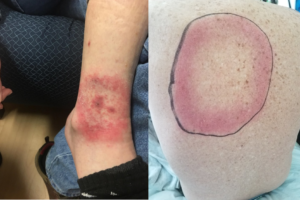Please view the May 2021 Case of the Month below:
Submitted by:
Rachel Friedman-Moraco, MD
Associate Professor of Medicine
Department of Medicine, Division of Infectious Diseases
Emory University School of Medicine
CASE
A 57 year-old male from Georgia with Stage IV Mantle Cell Lymphoma underwent autologous hematopoietic stem cell transplant. On day #10 post-transplant, he developed fevers to > 40 C, headache, and multiple large erythematous skin lesions with central clearing on his right arm, right anterior chest extending to his right scapula, left scapula, and right ankle (see images). He had no other systemic symptoms. Fevers persisted despite > 48 hours of broad spectrum antimicrobial therapy. He endorsed multiple tick bites prior to admission, including retained mouth parts at the site of largest skin lesion for > 48 hours. Treatment was initiated with doxycycline and fever resolved within 24 hours, followed by resolution of the skin lesions over the next few days. Acute and convalescent serologies for E. chaffeensis, RMSF and B. burgdorferi were negative.
What is your diagnosis?
ANSWER AND EXPLANATION
FINAL DIAGNOSIS?
STARI- Southern Tick Associated Rash Illness
DISCUSSION
STARI causes a similar rash presentation to that of Lyme disease (Borrelia burgdorferi) transmitted by Ixodes scapularis, however the vector is the Lonestar tick (Amblyomma americanum). The etiologic agent is unknown. Skin lesions tend to be larger and multiple in STARI compared to Lyme disease. Serious systemic complications are not typically seen with STARI, however treatment with doxycycline is recommended. STARI in immunocompromised patients has not been widely reported, however there is concern that they may be at risk for more severe manifestations. This patient was treated with a 14 day course of doxycycline.
CITATIONS
- Edwin J Masters, Chelsea N Grigery, Reid W Masters. STARI, or Masters disease: Lone Star tick-vectored Lyme-like illness. Infectious Disease Clinics of North America. 2008 June; 22(2); 361-76.
- Lucas Blanton, Brad Keith, Walter Brezinksi. Southern tick-associated rash illness: erythema migrans is not always Lyme disease. Southern Medical Journal. 2008, Vol. 101(7): 759-760.
Acknowledgements:
Nathan Summers, Mary Jo Lechowicz, Mona Shums



Be the first to comment on "Faculty Development Case of the Month: May 2021"